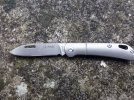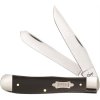Elgatodeacero
Gold Member
- Joined
- Jan 5, 2014
- Messages
- 3,131
If an artificial intelligence robot could make knives using traditional materials and methods, and no human input, is that more traditional than a single human craftsman using modern materials and methods to make a knife by hand?
I think a lot of this “what is traditional” is based on aesthetics and very parochial opinions.
I think a lot of this “what is traditional” is based on aesthetics and very parochial opinions.






